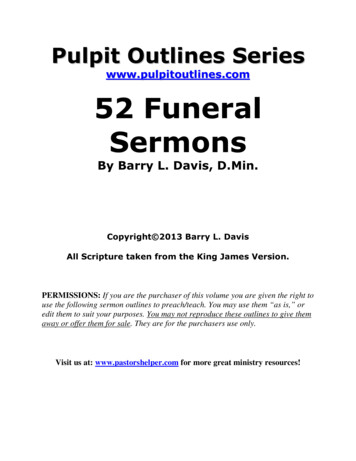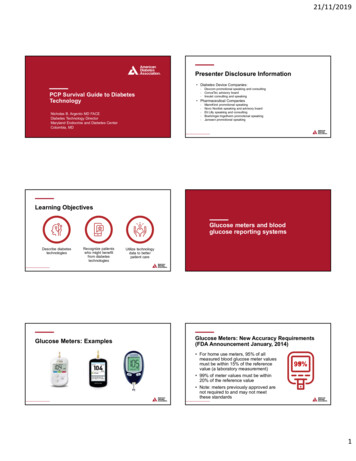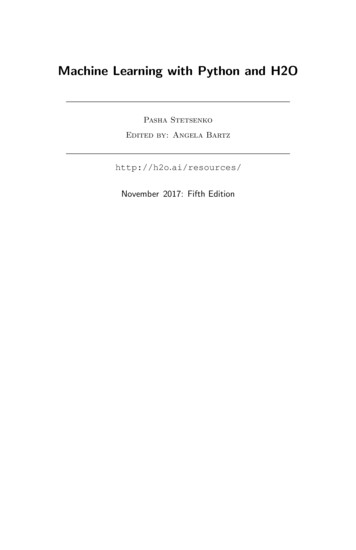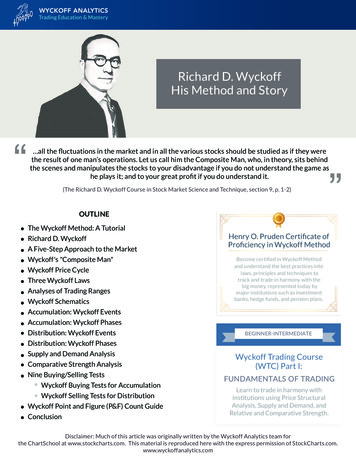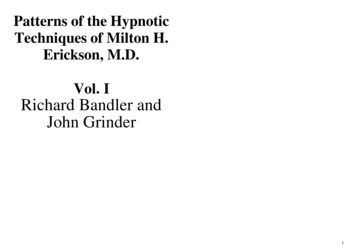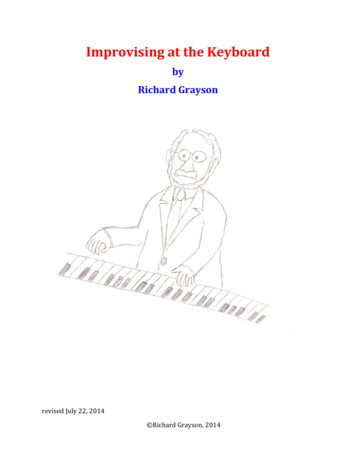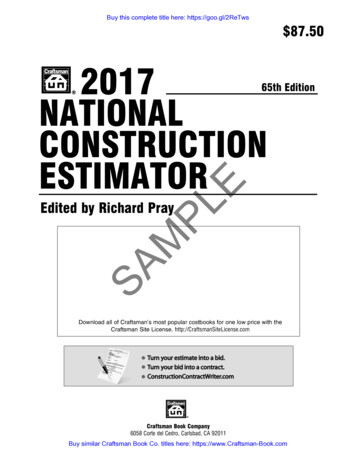
Transcription
Buy this complete title here: https://goo.gl/2ReTws 87.502017NATIONALCONSTRUCTIONESTIMATOR65th EditionSAMPLEdited by Richard PrayE Download all of Craftsman’s most popular costbooks for one low price with theCraftsman Site License. http://CraftsmanSiteLicense.comTurn your estimate into a bid.Turn your bid into a contract.ConstructionContractWriter.com Craftsman Book Company6058 Corte del Cedro, Carlsbad, CA 92011Buy similar Craftsman Book Co. titles here: https://www.Craftsman-Book.com
Buy this complete title here: https://goo.gl/2ReTwsContentsA complete index begins on page 638EConstruction Economics Division.305Industrial & Commercial Division Labor Cost.307Industrial and Commercial Division. 308-63701 General Requirements. 308-33002 Existing Conditions. 330-33603 Concrete. 336-369Concrete formwork.337Reinforcing steel.344Foundations.35904 Masonry. 369-380Reinforcing and flashing.370Brick and block walls.37105 Metals. 381-387Structural steel.381Steel floor and roof decking.38206 Wood and Composites. 387-395Framing carpentry.38707 Thermal & Moisture Protection. 395-410Thermal insulation.396Roof insulation.397Membrane roofing.39908 Openings. 410-421Metal doors.410Hardware.41809 Finishes. 421-438Gypsum wallboard.421Ceilings and flooring.42710 Specialties. 438-447Partitions.44111 Equipment. 447-46812 Furnishings. 468-47313 Special Construction. 473-48614 Conveying Equipment. 486-48921 Fire Suppression. 489-49122 Plumbing. 492-533Pipe and fittings.492Hangers and supports.514Valves, pumps, gauges.51723 HVAC. 533-539Gas fired heaters.533Hydronic & steam heating.53526 Electrical. 539-586Rigid steel conduit.541EMT conduit and wire.544PVC conduit and wire.549Conduit supports & hangers.552Wire and cable.555Lighting.58027 Communications. 587-59231 Earthwork. 592-607Excavation and backfill.595Shoring, bulkheads, piles.60332 Exterior Improvements. 607-624Paving and curbs.607Fencing and gates.61533 Utilities. 624-637Pressure water pipe.626Drain pipe.628Index.638SAMPLHow to Use This Book. 3-5Abbreviations and Symbols.6Craft Codes and Crews. 7-9Residential Division Labor Cost.10Adjusting Labor Costs.11Area Modification Factors. 12-15Credits and Acknowledgments.16Residential Division. 17-304Adhesives.17Basement doors.23Building permit fees.28Cabinets, kitchen.29Carpentry, rule of thumb.32Carpentry, assemblies.33Carpentry, piecework rates.37Carpentry, detailed breakdown.38Carpentry, finish work.51Carpentry, steel.56Ceilings, suspended.79Concrete work.84Decking.98Demolition.100Doors, jambs, frames, and trim.105Electrical work, subcontract.127Elevators and lifts, subcontract.132Excavation and backfill.134Fences.141Fire sprinkler systems.149Flooring.152Framing connectors.158Garage doors.163Glass, glazing.165Gutters and downspouts.166Gypsum drywall and accessories.167Hardware.168Heating and cooling.171Insulation.179Insurance and bonding.183Landscaping.185Lighting fixtures.188Log home construction.191Lumber and plywood.193Markup (overhead and profit).207Masonry.208Moldings.221Paint removal.232Paints, coatings, and umbing fixtures and equipment.244Plumbing and heating piping.250Roofing.254Sheet metal.266Siding.273Skylights.276Stairs.279Taxes, Payroll.283Tile .285Wallcoverings.291Windows.295Copyright 2016 Craftsman Book Company ISBN 978-1-57218-325-4 1st printing November 2016 for the year 2017Buy similar Craftsman Book Co. titles here: https://www.Craftsman-Book.com
Buy this complete title here: https://goo.gl/2ReTwsThis Book Is an Encyclopediaof 2017 Building CostsThe 2017 National Construction Estimator lists estimated construction costs to general contractors performing the work with their own crews, as of mid-2017.Overhead & profit are not included.This Manual Has Two Parts; the ResidentialConstruction Division begins on page 17. Use thefigures in this division when estimating the cost ofhomes and apartments with a wood, steel or masonryframe. The Industrial and Commercial Division beginson page 306 and can be used to estimate costs fornearly all construction not covered by the ResidentialDivision.Material Costs for each item are listed in the column headed “Material.” These are neither retail norwholesale prices. They are estimates of what mostcontractors who buy in moderate volume will pay suppliers as of mid-2017. Discounts may be available forpurchases in larger volume.Add Delivery Expense to the material cost forother than local delivery of reasonably large quantities.Cost of delivery varies with the distance from source ofsupply, method of transportation, and quantity tobe delivered. But most material dealers absorb thedeliv-ery cost on local delivery (5 to 15 miles) of largerquan-tities to good customers. Add the expense ofjob site delivery when it is a significant part of thematerial cost.EThe Residential Construction Division is arrangedin alphabetical order by construction trade and type ofmaterial. The Industrial and Commercial Division follows MasterFormat 2004. A complete index beginson page 638.Material CostsAdd Sales Tax when sales tax will be charged tothe contractor buying the materials.SAMPLWaste and Coverage loss is included inthe installed material cost. The cost of manymaterials per unit after installation is greater thanthe purchase price for the same unit because ofwaste, shrinkage or coverage loss during installation.For example, about 120 square feet of nominal 1" x4" square edge boards will be needed to cover 100square feet of floor or wall. There is no coverage losswith plywood sheathing, but waste due to cutting andfitting will average about 6%.Costs in the “Material” column of this book assumenormal waste and coverage loss. Small and irregular jobsmay require a greater waste allowance. Materials pricedwithout installation (with no labor cost) do not include anallowance for waste and coverage except as noted.Labor CostsResidential ConstructionDivision begins on page 172017 NationalConstruction EstimatorIndustrial & CommercialDivision begins on page 306Free 2017 National Estimatorsoftware download containsan electronic versionof this bookLabor Costs for installing the material or doingthe work described are listed in the column headed“Labor.” The labor cost per unit is the labor cost perhour multiplied by the manhours per unit shown afterthe @ sign in the “Craft@Hours” column. Labor costincludes the basic wage, the employer’s contributionto welfare, pension, vacation and apprentice funds andall tax and insurance charges based on wages. Hourlylabor costs for the various crafts are listed on page10 (for the Residential Division) and page 307 (for theIndustrial and Commercial Division).Hourly labor costs used in the Industrial andCommercial Division are higher than those used in theBuy similar Craftsman Book Co. titles here: https://www.Craftsman-Book.com3
Buy this complete title here: https://goo.gl/2ReTwsSupervision Expense to the general contractor isnot included in the labor cost. The cost of supervisionand non-productive labor varies widely from job to job.Calculate the cost of supervision and non-productivelabor and add this to the estimate.Payroll Taxes and Insurance included in the laborcost are itemized in the sections beginning on pages183 and 283.Manhours per Unit and the Craft performing thework are listed in the “Craft@Hrs” column. Pages 7through 9 explain the “Craft@Hrs” column. To find theunits of work done per man in an 8-hour day, divide 8by the manhours per unit. To find the units done by acrew in an 8-hour day, multiply the units per man per8-hour day by the number of crew members.Manhours Include all productive labor normallyassociated with installing the materials described. Thiswill usually include tasks such as:n Unloading and storing construction materials, toolsand equipment on site.truck on site at the beginning of the day.n Returning tools and equipment to a storage area orn Normal time lost for work breaks.Mtruck on site at the end of the day.n Planning and discussing the work to be performed.n Normal handling, measuring, cutting and fitting.SAn Keeping a record of the time spent and work done.n Regular cleanup of construction debris.n Infrequent correction or repairs required because offaulty installation.Adjust the Labor Cost to the job you are figuringwhen your actual hourly labor cost is known or can beestimated. The labor costs listed on pages 10 and 307will apply within a few percent on many jobs. But laborcosts may be much higher or much lower on the jobyou are estimating.If the hourly wage rates listed on page 10 or page307 are not accurate, divide your known or estimatedcost per hour by the listed cost per hour. The result isyour adjustment for any figure in the “Labor” column forthat craft. See page 11 for more information on adjusting labor costs.Adjust for Unusual Labor Productivity. Costsin the labor column are for normal conditions: experienced craftsmen working on reasonably well plannedand managed new construction with fair to good productivity. Labor estimates assume that materials arestandard grade, appropriate tools are on hand, workdone by other crafts is adequate, layout and installation4Working conditions at the job site have a majoreffect on labor cost. Estimating experience and careful analysis can help you predict the effect of mostchanges in working conditions. Obviously, no singleadjustment will apply on all jobs. But the adjustmentsthat follow should help you produce more accuratelabor estimates. More than one condition may applyon a job.n Add 10% to 15% when working temperatures arebelow 40 degrees or above 95 degrees.n Add 15% to 25% for work on a ladder or a scaffold,in a crawl space, in a congested area or remote fromthe material storage point.n Deduct 10% when the work is in a large open areawith excellent access and good light.n Add 1% for each 10 feet that materials must be liftedabove ground level.n Add 5% to 50% for tradesmen with below averageskills. Deduct 5% to 25% for highly motivated, highlyskilled tradesmen.n Deduct 10% to 20% when an identical task isPLn Moving tools and equipment from a storage area orare relatively uncomplicated, and working conditionsdon’t slow progress.EResidential Division, reflecting the fact that craftsmenon industrial and commercial jobs are often paid morethan craftsmen on residential jobs.repeated many times for several days at the samesite.n Add 30% to 50% on small jobs where fitting andmatching of materials is required, adjacent surfaceshave to be protected and the job site is occupiedduring construction.n Add 25% to 50% for work done following a majorflood, fire, earthquake, hurricane or tornado whileskilled tradesmen are not readily available. Materialcosts may also be higher after a major disaster.n Add 10% to 35% for demanding specs, rigid inspec-tions, unreliable suppliers, a difficult owner or aninexperienced architect.Use an Area Modification Factor from pages 12through 15 if your material, hourly labor or equipmentcosts are unknown and can’t be estimated.Here’s how: Use the labor and material costs inthis manual without modification. Then add or deductthe percentage shown on pages 12 through 15 to estimated costs to find your local estimated cost.Equipment CostsEquipment Costs for major equipment (such ascranes and tractors) are listed in the column headed“Equipment.” Costs for small tools and expendablesupplies (such as saws and tape) are usually considered overhead expense and do not appear in theEquipment cost column.Buy similar Craftsman Book Co. titles here: https://www.Craftsman-Book.com
Buy this complete title here: https://goo.gl/2ReTwsSubcontracted WorkSubcontractors do most of the work on construction projects. That’s because specialty contractors canoften get the work done at competitive cost, even afteradding overhead and profit.You wouldn’t bid a job under those conditions. Andwe don’t claim that all construction is done at these prices.Estimating Is an Art, not a science. On manyjobs the range between high and low bid will be 20%or more. There’s room for legitimate disagreement onwhat the correct costs are, even when complete plansand specifications are available, the date and site areestablished, and labor and material costs are identicalfor all bidders.No cost fits all jobs. Good estimates are custommade for a particular project and a single contractorthrough judgment, analysis and experience.This book is not a substitute for judgment, analysisand sound estimating practice. It’s an aid in developingan informed opinion of cost. If you’re using this book asyour sole cost authority for contract bids, you’re reading more into these pages than the editors intend.PLMany sections of this book cover work usuallydone by subcontractors. If you see the word “subcontract” in a section description, assume that costs arebased on quotes by subcontractors and include typicalsubcontractor markup (about 30% on labor and 15%on material). Usually no material or labor costs willappear in these sections. The only costs shown will bein the “Total” column and will include all material, laborand equipment expense.How Accurate Are These Figures? As accurateas possible considering that the estimators who wrotethis book don’t know your subcontractors or materialsuppliers, haven’t seen the plans or specifications, don’tknow
without installation (with no labor cost) do not include an allowance for waste and coverage except as noted. Labor Costs Labor Costs for installing the material or doing the work described are listed in the column headed “Labor.” The labor cost per unit is the labor cost per



